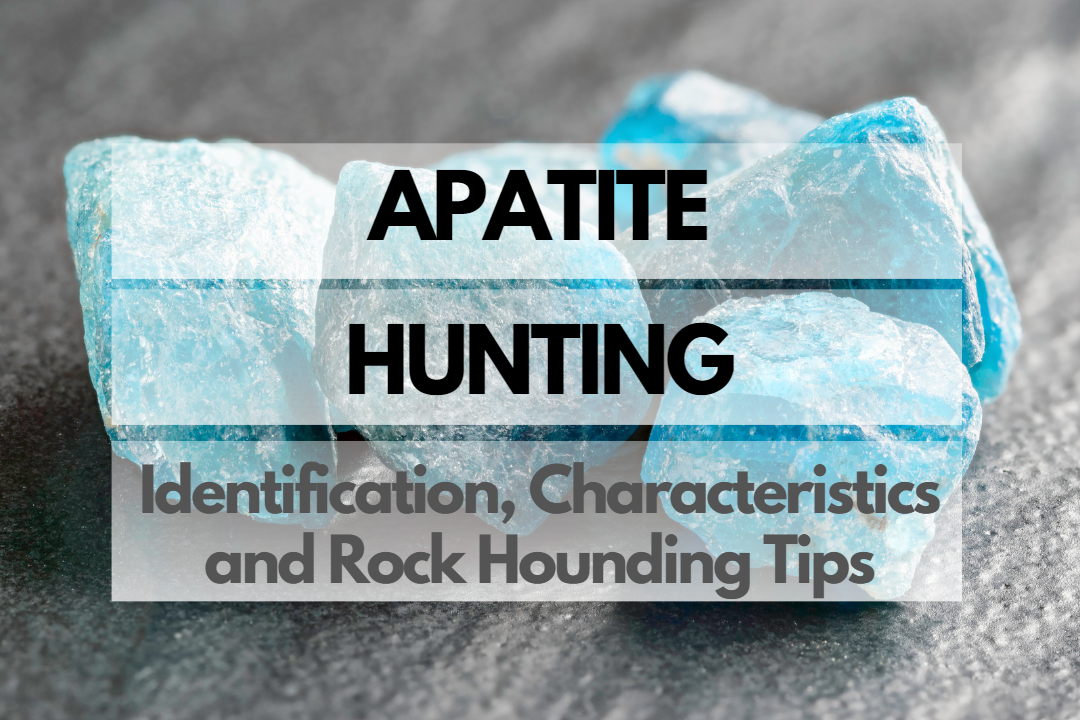Embarking on an Apatite hunting adventure can be a fascinating and rewarding experience for rock enthusiasts of all ages. Apatite, a group of phosphate minerals, captivates collectors with its stunning colors and unique crystal formations. In this article, we’ll explore the history, identification, characteristics, and uses of Apatite, along with some tips to help you find, identify, and appreciate this remarkable mineral.
History & Origin of Apatite
Apatite derives its name from the Greek word “apatáo,” which means “to deceive” or “to be misleading.” This is because Apatite can be easily mistaken for other gemstones, such as peridot, tourmaline, or beryl. Apatite was first described by German geologist Abraham Gottlob Werner in 1786, and since then, it has been found in various locations worldwide. Culturally, Apatite has been associated with different beliefs and practices, such as improving communication, enhancing creativity, and fostering a sense of clarity and focus.
Apatite Identification & Physical Properties
To identify Apatite and appreciate its unique characteristics, it’s essential to understand its physical properties. Here’s an overview of Apatite’s physical properties in an HTML table:
| Property | Value |
|---|---|
| Chemical Formula | Ca5(PO4)3(F,Cl,OH) |
| Crystal System | Hexagonal |
| Luster | Vitreous to subresinous |
| Transparency | Transparent to translucent |
| Specific Gravity | 3.16 – 3.22 |
| Streak | White |
Apatite Colors
Apatite displays a wide range of colors, including blue, green, yellow, brown, pink, purple, and even colorless. The most sought-after and valuable Apatite is the neon blue to blue-green variety, commonly known as “Paraíba-like” Apatite due to its resemblance to the rare and prized Paraíba tourmaline.
Apatite Hardness
Apatite has a Mohs hardness of 5, which makes it relatively soft compared to other gemstones. Due to its lower hardness, Apatite is more susceptible to scratches and chips, so it requires careful handling and storage to maintain its beauty and integrity.
Apatite Types
Fluorapatite
Fluorapatite is the most common variety of Apatite and contains fluorine as its primary anion. Its colors range from blue to green, yellow, and more, and it is often used in the production of phosphoric acid, a key component of fertilizers.
Chlorapatite
Chlorapatite contains chlorine as its primary anion and is less common than Fluorapatite. This variety can be found in hues of green, blue, and brown and is often associated with metamorphic rocks.
Hydroxylapatite
Hydroxylapatite contains hydroxide as its primary anion and is a vital component of our bones and teeth. This variety is typically found in white to pale yellow colors and is mainly used in biomedical applications, such as bone grafts and dental implants.
Apatite Uses
Apatite has various uses, including:
- Gemstone: Apatite’s vibrant colors and unique crystal formations make it a popular choice for jewelry and decorative items.
- Fertilizer: Apatite is a significant source of phosphorus, which is essential for plant growth and is used in the production of fertilizers.
- Biomedical applications: Hydroxylapatite’s similarity to human bone material makes it an essential material for bone grafts, dental implants, and other medical applications.
- Mineral specimens: Collectors treasure Apatite for its diverse colors and crystal habits, making ita sought-after addition to mineral collections.
How Much Is Apatite Worth?
Apatite’s value can vary widely depending on factors such as color, clarity, size, and overall quality. In general, Apatite can range from $5 to $100 per carat, with the more valuable specimens featuring intense colors, excellent clarity, and larger sizes. It’s important to note that gem-quality Apatite is relatively rare, so top-quality specimens can be quite valuable and highly prized by collectors.
Apatite Rock Hounding Tips
Ready to embark on an exciting Apatite hunting adventure? Here are some tips and tricks to help make your expedition a success!
Essential Tools and Equipment
Having the right tools and equipment can make a significant difference in your rock hounding experience. Some essentials for Apatite hunting include:
- Rock hammer: A versatile and indispensable tool for breaking rocks and extracting specimens.
- Chisel: Useful for splitting rocks and prying out Apatite crystals.
- Hand lens: A 10x magnification hand lens helps you examine and identify Apatite more easily.
- Protective gear: Safety goggles, gloves, and sturdy footwear are essential for protecting yourself during rock hounding.
- Backpack: A durable backpack to carry your finds, tools, and other essentials.
Safety Tips
Rock hounding can be a fun and rewarding hobby, but it’s important to prioritize safety. Keep these tips in mind:
- Always let someone know where you’re going and when you expect to return.
- Carry a fully charged mobile phone, map, compass, and GPS device for navigation.
- Bring plenty of water, snacks, and sunscreen to stay hydrated and protected from the sun.
- Pay attention to local weather conditions and avoid rock hounding during storms or extreme temperatures.
- Be aware of your surroundings, including wildlife, unstable terrain, and other potential hazards.
Apatite Hunting: Where to Find Apatite
Apatite can be found in various locations around the world, with some regions being particularly well-known for their abundant Apatite deposits. Here’s an overview of the best places to find Apatite, followed by an HTML table detailing specific sites and areas:
| Site/Area | Location |
|---|---|
| Yukon Territory | Canada |
| Durango | Mexico |
| Panasqueira Mines | Portugal |
| Ihovitra | Madagascar |
| Slyudyanka | Russia |
| Minas Gerais | Brazil |
Caring For Your Apatite
Due to its relatively low hardness, Apatite requires proper care and handling to maintain its beauty and integrity. Here are some tips for caring for your Apatite:
- Store Apatite specimens separately in a soft cloth or padded container to prevent scratches and damage.
- Clean Apatite using a soft brush and mild soap, then rinse thoroughly with lukewarm water. Avoid using harsh chemicals or ultrasonic cleaners, as they may damage the stone.
- Keep Apatite away from extreme heat, sudden temperature changes, and direct sunlight to prevent color fading and structural damage.
Additional Resources
For further information and resources on Apatite and rock hounding, consider the following:
- United States Geological Survey (USGS): https://www.usgs.gov/
- Mindat.org: https://www.mindat.org/
- Rock & Gem Magazine: https://www.rockngem.com/
- Books: “Collector’s Guide to the Apatite Group” by Robert J. Lauf
- Forums & Communities: The Rockhound Connection (Facebook group)
Additional Apatite FAQs
Here are some frequently asked questions about Apatite that we haven’t covered yet:
Do Apatite have any healing properties?
Many people believe that Apatite has various metaphysical and healing properties. While there’s no scientific evidence to support these claims, some enthusiasts attribute Apatite with helping to improve concentration, communication, and personal growth. It’s important to remember that healing crystals should not replace professional medical advice and treatment.
Do Apatite have any spiritual meaning?
In the realm of crystal healing and spirituality, Apatite is often associated with the throat chakra, which is believed to influence self-expression, creativity, and communication. Apatite is also said to help with spiritual attunement, enhancing psychic abilities and intuition.
Do I need a permit to go Apatite hunting?
In some cases, you may need a permit for rockhounding, especially if you’re planning to collect specimens on public lands or protected areas. Regulations vary depending on the specific location, so it’s essential to research the rules and obtain any necessary permits before you go. For more information on permits in the United States, visit the Bureau of Land Management (BLM) website: https://www.blm.gov/.
Closing Thoughts
Apatite hunting can be an exciting and rewarding adventure, providing you with the opportunity to discover stunning crystals while exploring the great outdoors. With the right tools, safety precautions, and knowledge of where to find Apatite, you’re well on your way to a successful rock hounding experience. So, gather your gear, plan your next expedition, and enjoy the thrill of uncovering these beautiful gems!

